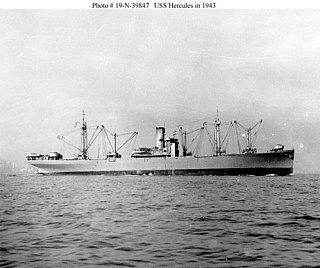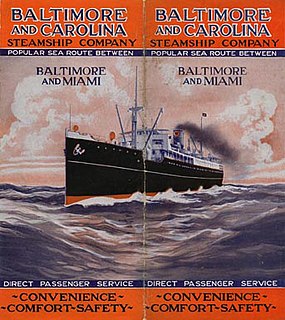
Newport News Shipbuilding (NNS), a division of Huntington Ingalls Industries, is the largest industrial employer in Virginia, and sole designer, builder and refueler of United States Navy aircraft carriers and one of two providers of U.S. Navy submarines. Founded as the Chesapeake Dry Dock and Construction Co. in 1886, Newport News Shipbuilding has built more than 800 ships, including both naval and commercial ships. Located in the city of Newport News, its facilities span more than 550 acres (2.2 km2), strategically positioned in one of the great harbors of the East Coast.

USS Charger (CVE-30) was an escort carrier of the United States Navy during World War II converted from a commercial C3-P&C cargo/passenger liner hull built as Rio de la Plata intended for the Moore-McCormack company's American Republics Line serving the east coast of South America. The ship was requisitioned for conversion to an escort carrier type intended for Royal Navy use and initially commissioned as HMS Charger (D27). Days later the transfer was rescinded with the ship returning to U.S. Navy control to become USS Charger which operated throughout the war as a training ship on the Chesapeake Bay with two ferry missions to Bermuda and Guantánamo Bay, Cuba.

The New York Shipbuilding Corporation was an American shipbuilding company that operated from 1899 to 1968, ultimately completing more than 500 vessels for the U.S. Navy, the United States Merchant Marine, the United States Coast Guard, and other maritime concerns. At its peak during World War II, NYSB was the largest and most productive shipyard in the world. Its best-known vessels include the destroyer USS Reuben James (DD-245), the cruiser USS Indianapolis (CA-35), the aircraft carrier USS Kitty Hawk (CV-63), the nuclear-powered cargo ship NS Savannah, and a quartet of cargo-passenger liners nicknamed the Four Aces.

Union Iron Works, located in San Francisco, California, on the southeast waterfront, was a central business within the large industrial zone of Potrero Point, for four decades at the end of the nineteenth and beginning of the twentieth centuries.

SS Washington was a 24,189-ton luxury liner of the United States Lines, named after the US capital city. On 6 June 1941, the Washington was commissioned as the troopship USS Mount Vernon. In 1947 one deck was restored to prewar condition and the ship resumed commercial service. In 1951 the ship was again used by the U.S. Government transporting soldiers and their families. The ship was laid up in 1953 and scrapped in 1965.

USS Refuge (AH-11), was a hospital ship of the United States Navy during World War II. The ship was built in 1921 by the New York Shipbuilding Corp., of Camden, New Jersey, as SS Blue Hen State, but was renamed President Garfield in 1923 and then SS President Madison in 1940 for service with American President Lines. Acquired by the Navy from the War Shipping Administration on 11 April 1942 the ship was commissioned as the transport USS Kenmore until conversion to a hospital ship.

Type C3-class ships were the third type of cargo ship designed by the United States Maritime Commission (MARCOM) in the late 1930s. As it had done with the Type C1 ships and Type C2 ships, MARCOM circulated preliminary plans for comment. The design presented was not specific to any service or trade route, but was a general purpose ship that could be modified for specific uses. A total of 162 C3 ships were built from 1939 to 1946.

USS Hugh L. Scott (AP-43) was a Hugh L. Scott-class transport ship. She was built in 1921 and spent 20 years in merchant service as a passenger and cargo liner. In July 1941 the ship was delivered to the United States Department of War for Army service as the United States Army Transport Hugh L. Scott operating in the Pacific. In August 1942 the ship was transferred to the United States Navy for conversion to an attack transport, served as a troopship in Operation Torch in November 1942, and was sunk by a U-boat four days later. 59 crewmen and soldiers died during the sinking.

USS Mizar (AF-12) was the United Fruit Company fruit, mail and passenger liner Quirigua that served as a United States Navy Mizar-class stores ship in World War II.

USS Merak (AF-21), the second Navy ship of the name, was the United Fruit Company cargo and passenger liner Veragua that served as a United States Navy Mizar-class stores ship in World War II.

The Seattle-Tacoma Shipbuilding Corporation was a United States corporation which built escort carriers, destroyers, cargo ships and auxiliaries for the United States Navy and merchant marine during World War II in two yards in Puget Sound, Washington. It was the largest producer of destroyers (45) on the West Coast and the largest producer of escort carriers of various classes (56) of any United States yard active during World War II.
The Pusey and Jones Corporation was a major shipbuilder and industrial-equipment manufacturer. Based in Wilmington, Delaware, it operated from 1848 to 1959.

The Type C4-class ship were the largest cargo ships built by the United States Maritime Commission (MARCOM) during World War II. The design was originally developed for the American-Hawaiian Lines in 1941, but in late 1941 the plans were taken over by the MARCOM.

SS Frontenac Victory was a Victory ship built for the United States War Shipping Administration late in World War II under the Emergency Shipbuilding program. It saw service in the European Theater of Operations in the Atlantic Ocean during 1945, and in the immediate post-war period. SS Frontenac Victory was part of the series of Victory ships named after cities; this particular ship was named after the city of Frontenac, Missouri. It was a type VC2-S-AP2/WSAT cargo ship with the U.S. Maritime Commission (MARCOM), "Victory" (MCV) hull number 625, shipyard number 1597, and built by Bethlehem Shipbuilding Corporation in Baltimore, Maryland.

The Type R ship is a United States Maritime Administration (MARAD) designation for World War II refrigerated cargo ship, also called a reefer ship. The R type ship was used in World War II, Korean War, Vietnam War and the Cold War. Type R ships were used to transport perishable commodities which require temperature-controlled transportation, such as fruit, meat, fish, vegetables, dairy products and other foods. The US Maritime Commission ordered 41 new refrigerated ships for the US Navy. Because of the difficulty of building refrigerated ships only two were delivered in 1944, and just 26 were delivered in 1945 and the remainder in 1946–48. The 41 R type ships were built in four groups. Two of design types were modified type C1 ships and two were modified type C2 ships. The United Fruit Company operated many of the R type ships in World War II. The type R2-S-BV1 became the US Navy Alstede-class stores ship and the type R1-M-AV3 became the US Navy Adria-class stores ship.

Craig Shipbuilding was a shipbuilding company in Long Beach, California. To support the World War I demand for ships Craig Shipbuilding shipyard switched over to military construction and built: US Navy Submarines and Cargo Ships. Craig Shipbuilding was started in 1906 by John F. Craig. John F. Craig had worked in Toledo, Ohio with his father, John Craig (1838-1934), and Blythe Craig, both shipbuilders, their first ship was built in 1864 at Craig Shipbuilding Toledo. John F. Craig opened his shipbuilding company in Port of Long Beach on the south side of Channel 3, the current location of Pier 41 in the inner harbor, becoming the port's first shipyard. In 1907 Craig Shipbuilding is given a contract to dredge a channel from the Pacific ocean to the inner harbor. In 1917 Craig sold the shipyard to the California Shipbuilding Company. But then opened a new shipyard next to the one he just sold and called it the Long Beach Shipbuilding Company. The Long Beach Shipbuilding Company built cargo ships in 1918, 1919, and 1920 for the United States Shipping Board.
Mississippi Shipping Company of New Orleans, Louisiana was a passenger and cargo steamship company founded in 1919. In 1961 officially changed its name to the Delta Line. The Mississippi Shipping Co. serviced port from the Gulf of Mexico and east coast of South America. The Mississippi Shipping Co. was formed to support coffee merchants and Brazilian produce to New Orleans and up the Mississippi River. competing with the New York City trade. Delta Line failed to upgrade to container ships and modernize as other shipping lines did in the 1970s. In 1982 Delta Line, now owned the Holiday Inn Corporation sold the line to Crowley Maritime. Crowley was the largest US barge and tugboat operator at the time. Crowley started to modernize the ships on the route, but sold the shipping line to the United States Lines in 1985. United States Lines but some of the ship into its routes but went bankrupt in 1986. At its peak in 1949, the Mississippi-Delta line owned 14 ships at a total of 98,000 grt. Delta Line also moved into passenger cruise with to ship. During World War II the Mississippi Shipping Company was active with charter shipping with the Maritime Commission and War Shipping Administration. During wartime, the Mississippi Shipping Company operated Victory ships, Liberty shipss, and a few Empire ships.

A. H. Bull Steamship Company was a shipping company and passenger liner service founded in New York City in 1902 by Archibald H. Bull (1848-1920). Service started with shipping between New York and Florida. His fleet of ships then added service to other Eastcoast ports. The company is also often called the Bull Lines and the Bull Steamship Line or A. H. Bull & Company. While founded in New York, Bull soon move its headquarter to Peir 5 in Baltimore, Maryland. Bull Lines main Eastcoast ports were: Baltimore, Charleston, Philadelphia, Tampa and Norfolk, Virginia. Oversea ports: Porto Rico, Antwerp, Bordeaux, Hamburg, Bremen, Copenhagen, and West Africa. Bull Steamship Line supported the US war effort for both World War I and World War II, including the loss of ships.

Sudden & Christenson Company was a shipping and lumber company founded in 1899. Edwin A. Christenson and Charles Sudden of San Francisco, California started the company and shipping line to supply northwest lumber to cities on the east coast, west coast and far east. The ships would return with goods and passengers from the remote ports. Some of the ships also had passager service on the upper decks. Sudden & Christenson Company and Los Angeles Steamship Company-United American Line started a joint venture called the Arrow Line in 1926. Arrow Line operated from Northwest Pacific Coast Ports and Argentina, Brazil and Uruguay. Sudden & Christenson's San Francisco Headquarters was at 110 Market Street with docks at Pier 15. Sudden & Christenson Company was incorporated in California in 1903. The Sudden & Christenson company dissolved in 1944 and Sudden & Christenson, Inc was founded to pay of the liability of franchise taxes, and operated till dissolved in 1965. Charles Sudden died in 1913 and Edwin Christenson became president with D. Walter Rasor as vice president. The company started with schooners and added steamships. During World War I Sudden & Christenson operated Merchant navy ships for the United States Shipping Board. During World War II Sudden & Christenson was active with charter shipping with the Maritime Commission and War Shipping Administration. Sudden & Christenson had docks in San Francisco, Vancouver, Seattle, Portland, Astoria, Los Angeles and Yokohama, Kobe, Shanghai, Dalian and Tsingtao. Far East ports were a joint venture with the North China Line. In late 1950s came the more cost-effective loading and unloading system, container shipping. The Sudden & Christenson fleet, now aged and on an obsolete system, put the company in decline, closing in 1965.
















